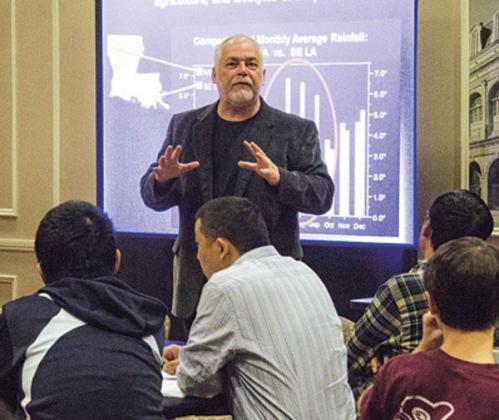
By Greta Jines Manship School News Service
Climate change, hurricanes and floods were hot topics during the Louisiana State University International Programs’ intercultural dialogue on weather, water and climate on Wednesday, with one presenter saying that whatever the extent of climate change will be Louisiana will be in the crosshairs.
Chief meteorologist at WAFB Jay Grymes opened the presentations with a focus on the state’s wet climate and the potential effects of climate change, warning that of the lower 48 states, Louisiana might be the most severely impacted in terms of climate change.
“(Even) if the threats of climate change are being overstated,” Grymes said, “and I’m not saying they are ... Louisiana is sure to be impacted.”
Barry Keim, a professor in the department of geography and anthropology and state climatologist, moved away from Louisiana’s climate and honed in on August’s historic flooding, exploring the storm’s evolution.
“I got up on Friday (Aug. 12) and it literally rained every waking minute of that day,” Keim said. “It was never not raining ... ended up with about 32 straight hours of rain.”
Keim presented a slideshow showcasing flooded areas around Baton Rouge, including a raft of ants piled up as a survival technique after suffering the loss of their mound. He compared the ants to the residents of Louisiana and their response to the flooding.
“It’s phenomenal how we tend to take care of each other in these kinds of events.”
Kam-Biu Liu, a professor and chair in LSU’s Department of Oceanography and Coastal Sciences, stressed the importance of long-term perspective because it aids in understanding environmental issues involving weather, water and climate and predicting related events in the future.
Other panelists included visiting scientists from China and Italy.
Fabrizio Donnarumma, a postdoctoral researcher in LSU’s Department of Chemistry, noted the differences between Europe and the U.S. in regard to natural disasters.
Donnarumma said he’s witnessed several catastrophes in Europe where entire neighborhoods and villages were not rebuilt. He compared that to Denham Springs where the trash and damage disappeared within months.
“People here have the power to rise up and start again,” Donnarumma said. “That’s actually a very nice message.”
